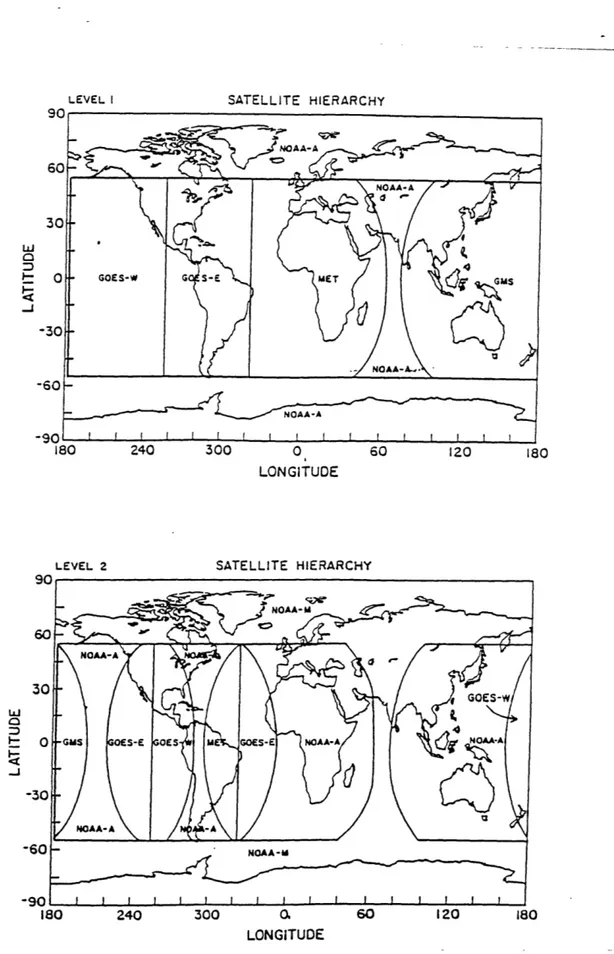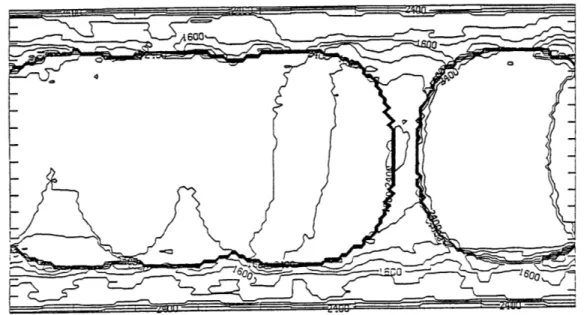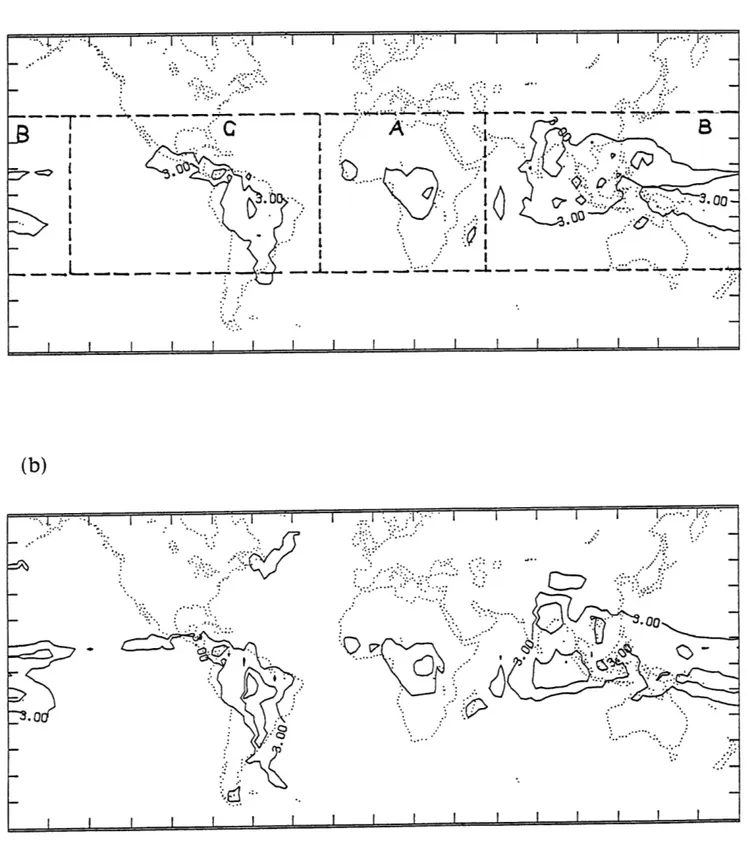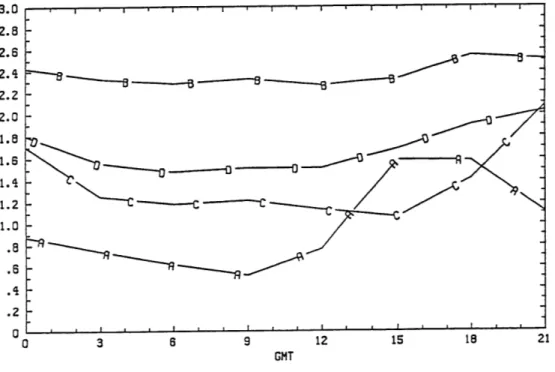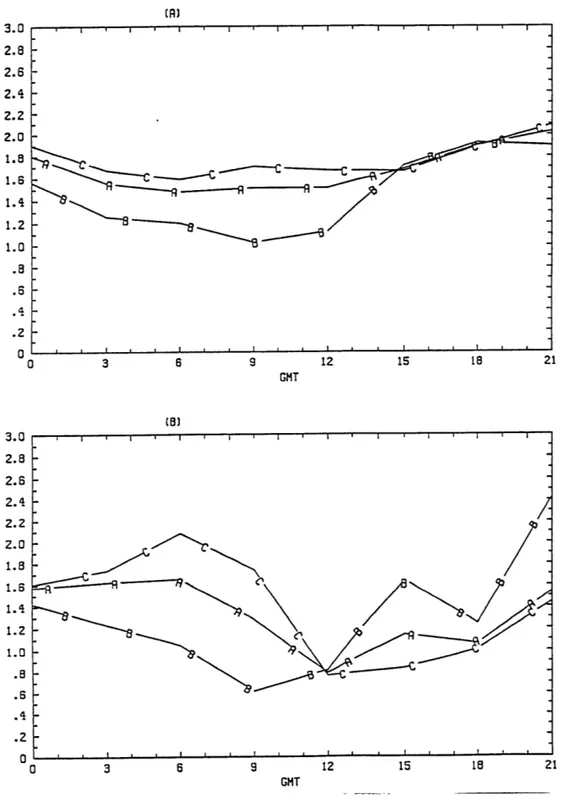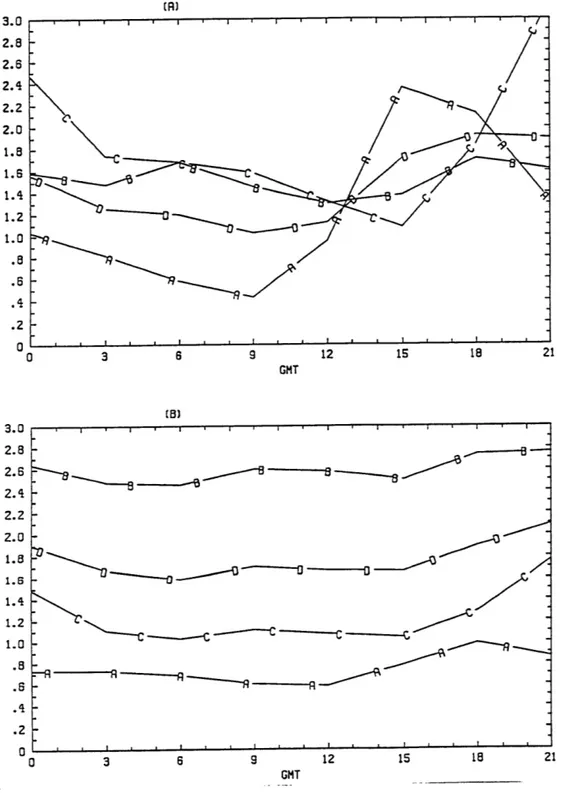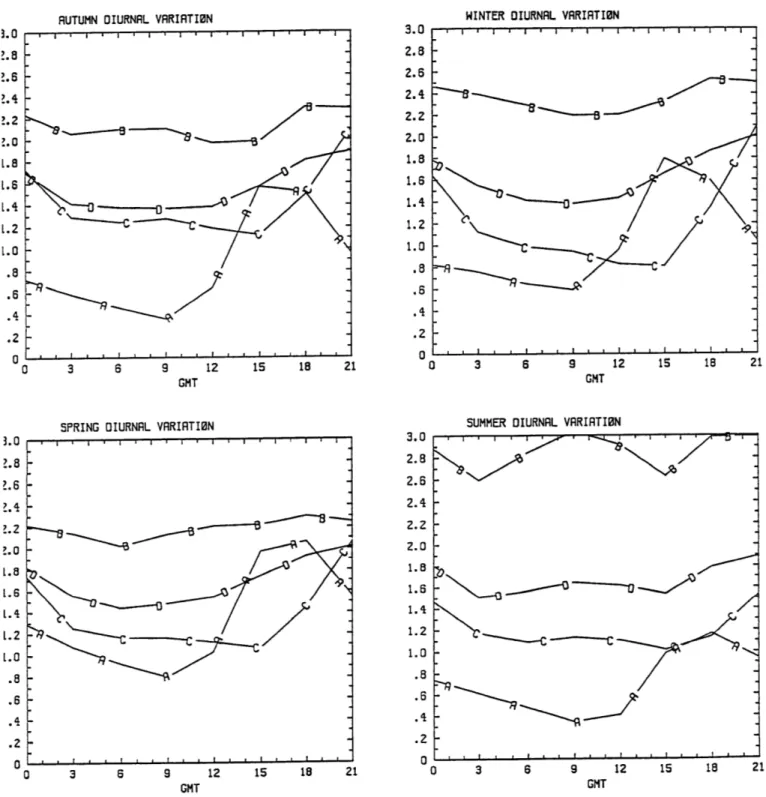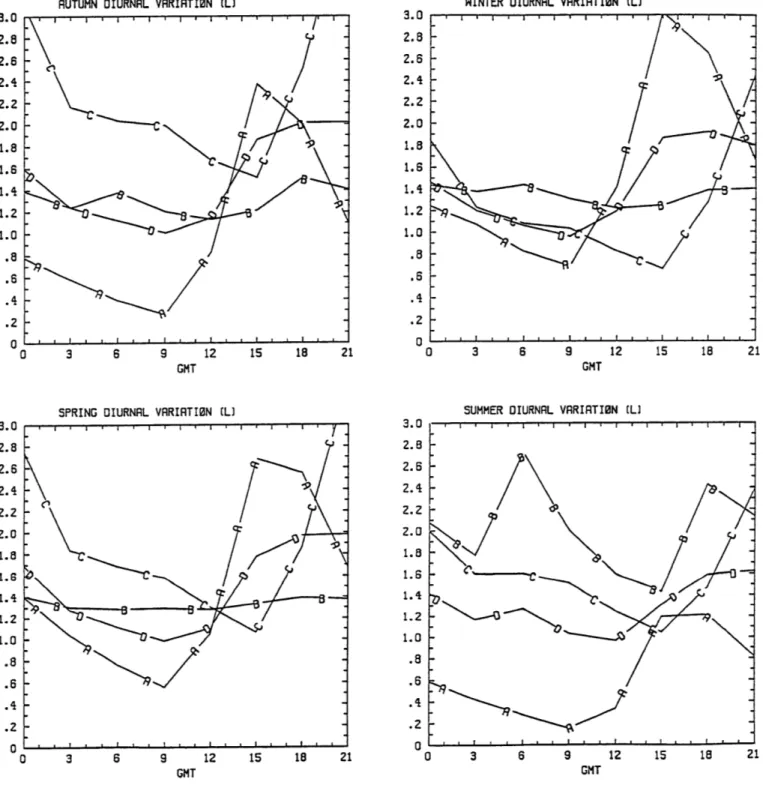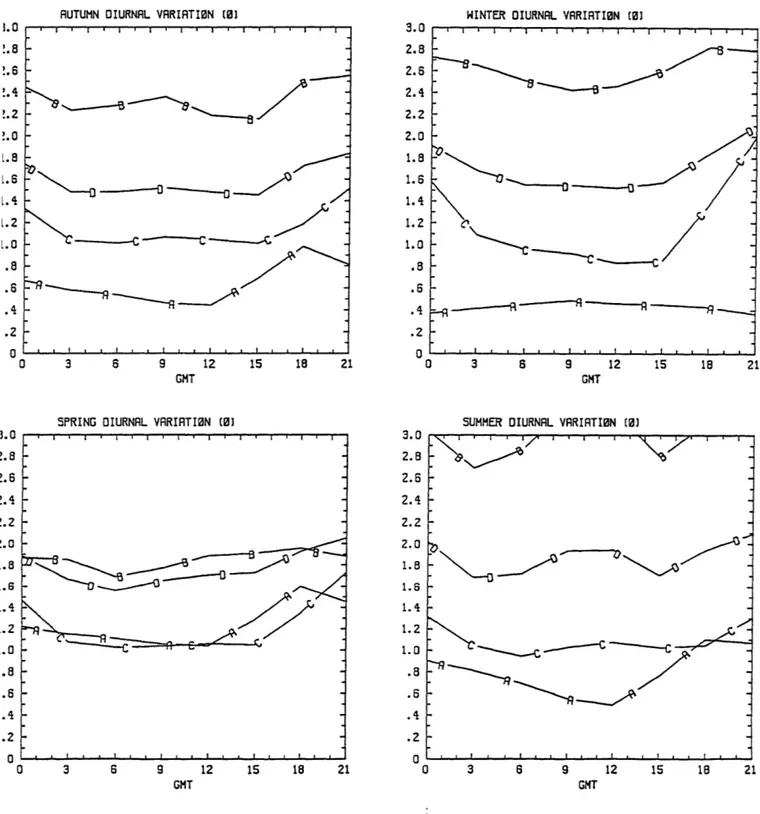DIURNAL CYCLE OF DEEP TROPICAL CONVECTION
by
Sewon Park
Submitted to the Department of
Earth and Atmospheric and Planetary Sciences in Partial Fulfillment of the requirements for the
Degree of MASTER OF SCIENCE
at the
Massachusetts Institute of Technology February 1992
1992 Sewon Park All rights reserved
The author hereby grants to MIT permission to reproduce and to distribute copies of this thesis document in whole or in part.
Signature of Author s
Department of Earth Atmospheric and Planetary Sciences January 18, 1992 Certified by
Professor Peter Stone Thesis Supervisor
Accepted By
-r,-Thomas H. Jordan Department Head
CONTENTS Abstract .... Introduction Data... Result... Conclusion.. Figures... References.. . . ...114 ... 15 ...26 ... 28 ...53 . . . . . . . . . . . . . . . . . . .. . . . . . . . . . . . . . . . . . . . . . .
DIURNAL CYCLE OF DEEP
TROPICAL CONVECTION BY
SEWON PARK
Submitted to the Department of Earth, Atmospheric and Planetary Sciences
on Jan 18, 1992 in partial fulfillment of the requirement for the Degree of Master of Science in
Atmospheric Science
ASTRACT
Deep tropical convection has long been recognized to play a central role in both the equatorial Hadley cell of the earth's general circulation and in supplying electric charge to global electrical circuit. It has become common to use cloud data extracted from satellite observations of visible and infra-red radiation as a proxy for tropical convection and condensation. Data from the International Satellite Cloud Climatology Project (ISCCP), which has three-hour time
resolution and is therefore adequate for calculating diurnal
variations, is becoming available. In this paper, the high cloud cover data from August 1983 to 1987 July are used to determine the
diurnal variation of deep convection.
Thesis Supervisor: Dr. Peter Stone
INTRODUCTION
Deep tropical convection has long been recognized to play a central role in both the equatorial Hadley cell of the earth's general circulation and in supplying electric charge to the global electrical
circuit.
Role in General Circulation
Because of the strong dependence of solar radiation and weak latitude dependence of outgoing infra-red radiation, there is a radiation excess in equatorial region and deficit in the polar region. The tropics is where the majority of the solar energy which drives the atmospheric heat engine is absorbed by the earth and transferred to the atmosphere. Therefore, an understanding of the tropics is very important for understanding the atmospheric system.
The mean rising motion in lower latitudes (the Intertropical Convergence Zone, ITCZ) transports heat upwards which they moves poleward as part of the Hadley cell. But the storage of available potential energy is very small due to the very small temperature gradients.
Riehl and Malkus (1958) showed that the stability of the tropical atmosphere was such that these simple transports would cool the upper troposphere and thus destroy potential energy. In order to satisfy the heat budget of the general circulation, they argued that only motion that followed a moist adiabatic ascent could actually heat the upper atmosphere. This could only be achieved by upward motion taking place through deep penetrative convection cells.
The large scale motions in the equatorial zone are driven primarily by latent heat release and this latent heating occurs primarily through cumulonimbus convection rather than large scale forced ascent. Thus the latent heating associated with condensation in tropical convection is the primary mechanism forcing the general circulation of the atmosphere. This heating drives the low latitude Hadely circulations which in turn are a major source of momentum for the mid-latitude jet stream. And the jet steam is the major source for mid-latitude eddies and weather.
Fluctuations in tropical convection can generate waves which propagate out of the tropics and transport energy to mid-latitudes (Hoskins and Karoly, 1981). The time it takes for wave energy to propagate from the tropics to mid-latitudes is only one to two weeks. So the fluctuations in tropical convection are important for the
Extensive observations of condensation in tropical convection are not available, so it has become common to use cloud data extracted from satellite observations of visible and infra-red radiation as a proxy for tropical convection and condensation. Richards and Arkin (1981) showed a good correlation between precipitation and cloud cover in the tropics. This research was limited to the specific area and may not apply to anomalous rainfall
situations. This deficiency may limit its extension to other areas.
Many studies using this proxy data have been done, e.g., interannual variations associated with El Nino, fluctuations associated with the 40-60 day Madden -Julian oscillation. Most of them have focused on long time scales. But there are much short time scales associated with planetary scale features. Thus there is a substantial need to document the climatology of fluctuations in tropical convection on short time scales.
Albright et. el. (1985) found a significant diurnal cycle in tropical convection, particularly over the land, but also over the ocean. At certain hours, the fractional coverage by clouds colder than -360C deviated by as much as 40% from the daily mean. The
variation was especially large in the South Pacific Convergence Zone (SPCZ). Many studies have been done on the diurnal variation of cloud cover in the tropics, but most of them were about the local time diurnal variation in specific areas. (Reed, Jaffe 1981, Raymond
1983, Richards and Arkins 1981, Rossow, Schiffer 1991 Fu et al.
Albright and Reed (1985) suggested two convective regimes in SPCZ, a first regime of very deep convection that grows during the night and peaks near sunrise and a second regime of less deep convection that develops rapidly around noontime, peaks in the middle to late afternoon. Rossow and Schiffer (1991) analyzed the diurnal variation of cloud cover for one month (July 1983). They showed that oceanic cloud amount variations are small except at low latitudes. Over the tropical land there is a significant phase difference from the surface temperature, possibly indicating a large semi-diurnal components. Also there is a significant regional variability of phase and amplitude of diurnal cycle in that month.
Role in Global Electricity
It is generally believed that thunderstorm electrical generators provide the source of the fair weather electrification and, in turn, the fair weather electrification is often used as the initial condition in proposed thunderstorm charge generation mechanisms.
The atmosphere is a conductor of electricity as a result of the presence of ions. It is easy to show that the atmospheric condensor, which has a 130vm-' field , would be discharged by the leakage current, which is about 3x10-2Am-2, in less than half an hour. Since
the field remains approximately constant, there must exist a supply current equal to the discharge current, which, as stated, is apparently provided by the thunderstorm acting as generator. Because of the low relatively low resistance of the upper conducting layer and the planetary surface, the charge is distributed over the globe in a time that is short compared with the decay time. Thus, the fair weather electric field in all parts of the world is influenced equally and simultaneously by thunderstorm currents regardless of their location, and the ionosphere is at a constant potential throughout the globe.
Wilson(1922) suggested that thunderstorms were the generator that maintained the fair weather field in the face of the conduction current that acts to discharge the field. He pointed out that the maximum potential gradient should occur when the most thundery regions of the earth attain their maximum activity. Brooks
(1925) estimated annual, seasonal, and latitudinal frequencies of thunderstorms over the land and oceans from the rather sketchy observations by weather stations and ships. He estimated that 1800 thunderstorms are simultaneously in progress. According to Gish and Wait (1950) conduction currents on the order of 1 ampere are measured over the tops of thunderstorms. This strongly supported Wilson's hypothesis, since a global current of 1,800 amperes is sufficient to balance the conduction current to earth in fair weather regions of the atmosphere (Chalmers, 1967).
The near surface fair weather potential gradient over the oceans, far from land, averages about 130vm-'. Over land, it changes a lot, depending on aerosol variations. The diurnal variation of the potential gradient is of particular interest. Over the land the diurnal variation also reflect the diurnal changes in the concentration of the aerosol, which are also tied to local time. However, over the ocean, there is a universal time dependent diurnal cycle. This universal diurnal variation presumably occurs over land as well, but is obscured by the effect of aerosols.
The Earth's fair-weather electric field intensity follows universal time (UT) rather than local time. Its variation within each 24 hour period is controlled by the integrated currents from globally distributed thunderstorms. The phase of the universal time diurnal variation of surface electric field (the Carnegie curve) shows a good agreement with the diurnal variation of thunder areas around the world. Mauchly(1923) showed the universal diurnal variation for the oceans on the basis of the measurements made on the several cruises of the R/V Carneigie.
Whipple (1929) refined Brook's estimates and judged that the diurnal variation of the potential gradient was similar to that of the number of thunderstorms in progress over the globe. Trent and Gathman (1972) counted oceanic thunderstorms based on more than
7 million observations made by ships at sea during 1949-1963.
There is a general correspondence between the global diurnal variation of the number of thunderstorms and electric field
measurements over the ocean (Mauchly 1926), and this evidence supports the theory that the global circuit is significantly modulated
by near-equatorial convection in the Maritime Continent, Africa, and
South America. Markson(1986) supported this idea by comparing the variation in area of the America sector highest clouds from a
GOES-E satellite analysis with variations of the ionosphere electric
potential.
Most researchers consider Wilson's model to be correct because it provides the only reasonable explanation for the atmospheric electric field. The normal 250 kilovolt potential difference between the earth's surface and the conductive upper atmosphere is maintained by the worldwide thunderstorm activity, which is predominantly located within 20 of the equator. Therefore, thunderstorms in the equator appear to be the most significant means for charging the earth.
The deep clouds, or cumulonimbus clouds, are the engine that drives the strong electrical generator manifested in lightning flashes and other electrical phenomena. Roughly speaking, the lateral size of an individual cloud is about the same as its height, and thunderstorms more often occur in groups than singly. The life of a
single cell averages about 20min, but the sequence of several cells leads to a storm lifetime of an hour or more. It has been recognized that thunderstorm activity has a pronounced concentration in the tropics, and within the tropical belt, a pronounced concentration over the land areas.
DATA
The International Satellite Cloud Climatology Project (ISCCP) was established as the first project of the World Climate Research Program (WCRP 1984) to collect and analyze satellite radiance measurements to infer the global distribution of cloud radiative properties and their diurnal and seasonal variations. Operational data collection and processing for ISCCP have been underway since July 1983. To obtain global averages while resolving diurnal variations, the project planned to use data from at least one polar-orbiting and five geostationary weather satellite.
Fig. 1-1 shows the regional coverage provided by satellites used for ISCCP.
The Satellites measured radiances in each pixel for VIS(O.6 p9m) and IR(1 lum) wavelengths which depend on ozone and water abundance. The data have been sampled to a pixel spacing of about 30Km . Hence in the cloud analysis each image pixel is treated as representing a specific scene about 30Km across. Each pixel was separated into cloudy and clear scenes. All image pixels containing
Original ISCCP plans called for reporting the properties of five cloud types ;low, middle, high, cirrus and deep convective clouds. The latter two types were qualitatively defined to be optically thin and thick high clouds, respectively. The cloud types are identified by their values of cloud top pressure and cloud optical thickness. To allow for diurnal studies and to study the effects of the cloud top adjustment procedure, the cloud top pressure distribution determined by the IR-only algorithm is also reported during the day-time along with the cloud top pressure distribution determined
by the VIS/IR algorithm but without the cloud top adjustment.
The deep convections in the tropics, in which we were interested have about 8 - 10 km height. Therefore, the highest cloud data can be the index of deep convection. In this paper, two kinds of cloud type are analyzed. The first is that with the lowest cloud top pressure (5mb < P < 180mb), which is determined by the VIS/IR algorithm. The second is that with the lowest cloud top pressure and the largest optical thickness(22.63 < TAU < 119.59). Because of the need for optical thickness these data were provided only in daytime. Fig. 1-2 shows the area for which visible data can be provided in each GMT hour.
The ISCCP retrieved detailed information about the global cloud properties every three hours throughout the month. The nominal spatial resolution is 250Km. The data was given on a longitude -latitude grid with 2.5 degrees resolution on both longitude and latitude. Thus 10368 grid cells (2.5 * 2.5 degrees longitude latitude)
cover the whole globe. Each such cell contained a certain total number of pixels. "Cloud Cover" in one grid cell for the respective cloud class is defined as follows.
Cloud Cover = Number of cloudy pixels / Total number of pixels
Fig. 2 shows the number of observations in a 1-year period. The 100% observation number is 2920. In this period the percent of observational coverage is at least 85% from 60N latitude to 60S latitude, except in the Indonesian Area, which is about 30%.
In this paper, the data from August 1983 to July 1987, were analyzed. Because of the Data Tape conditions, some period of the data are not included. Table 1. shows the periods which couldn't be used in this paper, and defines the seasonal means used.
In January 1985, the satellite 7 was changed to
NOAA-9. This satellite is important for the primary which used in the cloud analysis procedure. The data was calibrated to eliminate any discontinuities, to the extent possible (Rossow and Schiffer, 1991).
Table 1. 1983 0 0 0 0 0 1984 0 00 0 0 O0 0 0 O 0 0 0 0 1985 0 0 0 0 0 0 0 0 00 X 0 1986 0 0 0 0 0 0 0 2H 0 0 11H 0 1987 0 0 1H 1H 2H X 0
0: used X: unused 1H:first half used 2H: second half used
Autumn 1983(SEP,OCT,NOV) 1984(SEP,OCT,NOV) 1986(SEP,OCT,NOV)
Winter 1983(DEC)1984(JANFEB) 1984(DEC)1985(JAN,FEB)
1985(DEC)1986(JAN,FEB) 1986(DEC)1987(JAN,FEB)
Spring 1984(MAR,APR,MAY), 1985(MAR,APR,MAY) 1986(MAR,APR,MAY)
Summer 1984(JUN,JUL,AUG) 1985(JUN,JUL,AUG)
RESULT
Mean cloud cover
Fig 4. shows the geographical distribution of mean cloud cover
for two different period. In this map we can see 3 major convection
areas, America,especially South America, Africa and Asia with the
western equatorial Pacific.
Global diumal cycle
Fig 5. shows the four years average global diurnal cycle (D
line). The percent cloud coverage data were averaged from August
1983 to July 1987
in the tropics (31.25N - 31.25S) at each GMT
hour.
Also, shown for comparison, in Figure 3-1, is the carnegie
curve for the mean diurnal cycle of the global ionospheric potential.
The diurnal cycle of high cloud cover does indeed closely resemble
the diurnal cycle in Ionosphere potential, thus lending support to
Wilson's theory.
Each A,B,C line is the four year average diurnal cycle in the
respective sectors shown in Fig 4.
Because of the large amount of
cloud cover, the Asia-Austrailia sector ,B, is the major contributor
to the global deep cloud cover diurnal cycle.
Fig 6. shows the 4-year mean diurnal cycle over ocean and land.
Ocean and land are defined by whether the center of the grid cell is
located on land or on ocean from the map.
Line A is the total
tropical diurnal cycle, while lines B and C are the cycles over land
and ocean,respectively. The land cycle has a bigger amplitude, but
the ocean cycle is more similar to the total tropical cycle.
Fig 6(b)
is the same as Fig 6(a) but only the optically thick clouds, based on
the visible data, are included. Thus thick, night-time clouds are
excluded.(see Fig.1-2)
In section A, the diurnal cycle over ocean and land are very
similar. Over land, the maximum is at 15GMT which is 3-4PM in this
area. The maximum over ocean is 3 hours later than that over land.
This may be because it takes more time to heat the ocean. The
diurnal cycle amplitude of this section is very large because the
ratio of land area in this section is large,48%.
In section B, The diurnal cycle over the ocean shows two
maxima at 9 GMT and 18 GMT. In local time these are about 4-5PM
and 1-2AM. Over land, the maxima are at 6GMT and 18GMT. Because
of the three hours differences between the land and ocean, we can
suggest that the first maximum(1-2PM in the land and 4-5PM in the
ocean) is caused by diurnal heating. The second maximum(1-2AM in
both) must be caused by larger scale diurnal circulations, e.g.
Monsoon circulations.
In section C, the diurnal cycles over both land and ocean have
the same shape but different amplitudes. The maximum is at 21GMT
which is 2-3PM in the middle of this section. There is a remarkably
large diurnal cycle amplitude over land, but because 77% of this
section is ocean,there is still a big ocean contribution to the total
diurnal cycle.
Fig 7(a). shows the diurnal cycle of the whole tropics and of
each section over land.
For comparison, Fig 3-2 is the diurnal
variation of the world's thunderstorm areas from Brook's 1925
analysis. When we compare diurnal variation of the highest clouds
with Brook's analysis, the America section(C) contributes more from
3 to 9GMT than in Brook's analysis. Thus there is no dominant
contribution of Asia and Australia, section(B). But there is a big
contribution of section B land around 6GMT, as in Brook's analysis.
Land in section A is the major contributor from 12GMT to 18GMT.
Therefore this figure is very similar to Brook's analysis, but with a
3 hour shift, and a bigger and longer contribution of the America
section. Fig 7(b). is for the ocean. The variations are very flat in all
sections.
Seasonal diurnal cycle variation
Fig 8. shows the global and sectional diurnal cycle in each
season defined in the DATA section. Line D is the diurnal cycle in
whole tropics and line A,B and C represent each section.
There is
not much seasonal change in diurnal cycle for the whole tropics
except in summer. But, in separate sections there are clear seasonal
differences in diurnal cycle.
The diurnal cycle in section A moves up and down seasonally
without shape changes. In this section, the major convection area is
concentrated in the southern hemisphere. Therefore, the biggest
diurnal cycle is in northern spring and winter and the smallest is in
summer. In section C, the diurnal cycle changes seasonally without
change in shape, too. But there is a big amplitude in winter and very
little in summer. In this section, more convection is located in the
southern hemisphere than the northern hemisphere as shown in Fig 4.
Therefore, there can be a bigger diurnal cycle in northern winter
when the southern part of the convection area is stronger.
We can see big differences in the summer season. This is
caused by a big change in the section B diurnal cycle and decrease in
the section A diurnal cycle. When we look at Fig 4., most of the
convection area in section B is located in the northern hemisphere.
So in the northern summer, when the ITCZ is located in northern
hemisphere, the amount of high cloud cover in section B becomes
larger. Therefore, because of the big contribution of section B, the
diurnal cycle in summer shows a 9GMT maximum as well as the
usual 21GMT maximum.
Fig 9. show the seasonal diurnal cycles over land separately. The
diurnal cycles of the whole tropical land area have big amplitudes
but there are very small seasonal changes in either amplitude or
shape except in summer.
The diurnal cycles of sections A and C have big amplitudes. And
they change seasonally but differently from each other. When we
compare these two sections, section A has the biggest diurnal cycle
in winter and small diurnal cycle in summer. But in section C, a big
diurnal cycle is shown both in spring and autumn. These two diurnal
cycles compensate each other except in summer; therefore, we can
not see any seasonal change of total diurnal cycle associated with
changes of these two sections. Section B is very flat and has not
much change except in summer.
In autumn and spring, section C is the major contributor
except around 15GMT when the section A is the major contributor.
In winter, the major contributor is section A from 12GMT to 18GMT
and section B from 3GMT to 9GMT and section C from 18GMT to 3GMT.
This is very similar to Brook's(1925) analysis. In summer, section B
is the major contributor all the time.
There are unusual changes in summer. Especially, in section B
there is a big oscillation, associated with the Monsoon period. There
are two maxima which are 6GMT and 18GMT. These are about 1-4PM
and 1-4AM in that section. There is also a prominent decrease of the
Over ocean(Fig 10.), all of the diurnal cycles are very flat
compared to over land. There are still seasonal changes in the
diurnal cycles. Section B is the major contributor to the tropical
ocean diurnal cycle in all the seasons. In spring and summer, there
are big changes in the convection in section B.
The diurnal cycles of the separate sections are anti-correlated
with each other. Therefore, even though there are big changes in
diurnal cycles in individual sections, the total diurnal cycle is not
changed as much as that of each section.
Time series (monthly)
The mean, amplitude and standard deviation of each month's
diurnal cycle were calculated for the period of August 1983 to
February 1987.
November 1985, the missing month, is interpolated
from October and December. The mean is the average of the eight 3
hourly values in the diurnal cycle of each month.
The amplitude of
the diurnal cycle is defined by the difference between the maximum
and minimum in that diurnal cycle. The standard deviation is
calculated from the eight 3 hour mean data in each month. If the
diurnal cycle is complex, this will gives a letter measure of the
daily variation.
Fig 11. shows the mean, amplitude and standard deviation of
diurnal cycle for the whole tropical area(31.25N - 31.25S).
In the
mean data there is a jump at February 1985. It may be caused by the
satellite change described in DATA section. The amplitude may have
an annual cycle e.g., the minimum seems to occur every 12 months.
The standard deviation data is highly correlated with the amplitude
data. This means that most of the diurnal cycles have one maximum
and one minimum.
Fig 12. shows the same data but over land and ocean
separately. Over land there is a annual cycle in amplitude and mean.
They are very well correlated.
The maxima occur in October and
March and the minimum in July. Thus the high clouds over land are
well developed mostly in the transition seasons.
Over ocean, the variations in the diurnal cycle amplitude are
smaller than over land, and it is difficult to see any cycles in the
ocean data. These time series are more similar to the total, i.e., the
monthly change of the global diurnal cycle is dominated by ocean
areas.
Fig 13. shows the same data but for each section. In section A,
the annual cycle in the mean is more prominent. The amplitude of the
diurnal cycle also has an annual cycle which is well matched with
the mean's cycle. The maxima are in the southern winter season.
In section B, the mean of the diurnal cycle is very large, i.e,
this section is the biggest convection area. But the amplitude of the
diurnal cycle is very small compared to the other sections.
And
there is a big jump of mean near February 1985. This time is the
period when the NOAA satellite is changed, and that satellite covers
this B section. This circumstance may affect the cloud cover data in
this section. Unusually big amplitudes occurred from June 1984 to
September 1984.
In section
C,
there are bigger annual changes in the diurnal
cycle amplitudes.
The biggest amplitudes of diurnal cycle occur in
February and March. The mean data have a no obvious cycle.
In each sector AB and C, the same analyses are done for land
and ocean separately.(see Fig 14) In section A, land and ocean both
have a clear annual cycle. And both have March and April maxima.
However their minima are in June or July over land, but in January
over ocean. Therefore, land and ocean have different annual cycles
but both with maxima in March.
In section B(Fig.15), the land data has a clear annual cycle
with an August maximum and January or February minimum.
Therefore, it is clear that there is a strong association with the
monsoon. The amplitude data are very similar to the mean data. The
ocean shows very little annual cycle. An unusual peak is seen in
summer 1984, especially over land but also over ocean. In January
1983, there was a very strong El Nino.
This meant anomalous
heating in the Pacific. This type of event take a year or two to
re-equilibriate. This may have affected this period.
Over the ocean in sector C,(Fig.16) we cannot see any specific
cycle in the mean data, but, in amplitude there is a clear annual
cycle with a maximum in June. Over land, there is a half year period
cycle in both amplitude and mean data, with maxima in August and
February. In this sector, there are land areas in both hemispheres so
that, as the ITCZ moves from one hemisphere to the other, the
convection over land is well developed twice each year. Therefore,
in winter and summer, when ITCZ is located over land, the diurnal
cycle of cloud cover becomes larger.
In the C sector over land the cycles in the mean and amplitude
are bigger than those over ocean. But still there is a nonnegligible
annual cycle in the diurnal cycle amplitude over ocean, and because
of the larger area of ocean than land, the contribution of ocean to
total diurnal cycle becomes important. Actually the annual cycle in
the total convection in sector C is dominated by the annual cycle
over the oceans.
Correlation
Table 2. shows correlation coefficients of the time series for
different areas.
The mean of diurnal cycle for the whole tropics is most
correlated with section B, but the amplitude of the diurnal cycle is
the whole tropics land diurnal cycle section is the diurnal cycle of
America (section C). Over ocean, the diurnal cycle of section B is
most correlated with total ocean diurnal cycle.
In each section, the diurnal cycle of ocean and land are not
much correlated.
AREA MEAN AMPLITUDE Total Section A 30.1 56.5 Total Section B 80.1 59.5 Total Section C 60.7 63.7 Total LAND 60.9 63.6 Total OCEAN 96.2 84.3 LAND OCEAN 37.3 23.7 Section A : Section B -18.7 Section A : Section C 34.8 Section B : Section C 11.5 LAND Section A : Section B -30.7 -48.0 Section A : Section C - 3.2 48.2 Section B Section C - 1.3 -31.8
Land Total Section A 58.7 73.3
Land Total Section B 20.3 -10.7
Land Total Section C 63.6 72.2
OCEAN
Section A Section B 3.1 19.5
Section A Section C 3.8 -65.0
Section B Section C -12.6 -19.8
Ocean Total : Section A 24.1 8.0
Ocean Total : Section B 64.8 68.3
Ocean Total : Section C 53.2 44.3
SECTION A LAND OCEAN 0.4 -50.9 SECTION B LAND OCEAN 20.4 63.1 SECTION A LAND OCEAN 38.5 11.4
CONCLUSION
1) In tropics there are three major convection areas which are
America, especially South America, Africa and Asia with the
western equatorial Pacific.
2) The Diurnal cycle of high cloud cover closely resemble the
diurnal cycle in Ionosphere potential, thus lending support the
Wilson's theory.
3)
Asia-Austrailia region is the major contributor to the global
deep cloud cover diurnal cycle.
4) The diurnal cycle of the deep cloud cover over land is similar to
the world's thunderstorm area analysis by Brooks, but with a 3 hour
shift , and a bigger and longer contribution of the America section.
5) In each sections there are clear seasonal differences in diurnal
cycle. But, the seasonal changes of the diurnal cycle of the separate
sections are anti-correlated with each other.
Therefore, even
though there is a big seasonal change in diurnal cycle in individual
sections, the total diurnal cycle is not changed as much as that of
each section.
But, summer season shows very different diurnal cycle.
6) The monthly mean and amplitude of the diurnal cycle over the
land shows a very clear annual cycle.
The maxima occur in October
and March and minimum in July.
7) In each section, there are more clear annual cycle. In section A,
land and ocean both have a clear annual cycle, and both have March
and April maxima. However, their minima are in June or July over
land, but in January over ocean. In section B, the land data has a
clear annual cycle with an August maximum and January or February
minimum.
In section C, the land data has a half year cycle with
maxima in August and February.
8)
The mean of diurnal cycle for the whole tropics is most
correlated with section B, but the amplitude of the diurnal cycle is
SATELLITE HIERARCHY -90 L-180 LEVEL 2 240 300 0 60 120 LONGITUDE 180 SATELLITE HIERARCHY LO LONGITUDE
Fig 1-1
Regional coverage provided by satellites used for ISCCP:
Level 1 of hierarchy indicates the preferred satellite for eacr
location while Level 2 indicates the second choice used if the
preferred satellite is not available.
3'.,~ *'. I ,..t, 4 .f *~ ~1' I' S. ~,f *?~\ ~ -J-WWWLWJJ I I I' I-I-i -, 'V L k, I A ff I
83 AUG - 84 JUL (3HR INTERVAL OBS)
84 AUG - 85 JUL (3HR INTERVAL OBS)
Fig.
2
Number of observation in each one year period (a) August 1983 to
July 984. (b) August 1984 through July 1985. e.g., 2920 will be the complete
120 110 100
I
I
I
I
ALL CEANS (CARNEGiE) ALL...i,...f...,.
, ____________ o 2 4 6 8 10 12 14 - 16 18 20 22 24GMT
Fig. 3-1 Carnegie curve obtained from the average of electric field
measurements made by the Carnegie research vessel during
ocean cruises during the 1920's. (After Chalmers, 1957.)
A place Is regarded as hAving been in a thunder area at a
specified time if thunder was audble in the intem.al fren 120 60m before to 60m after that time.Th ok N 100 ~~ ~ -00 e 40 2 4 6 8 10 12 14 15 18 20 20 GM]
Fig. 3-2 Universal diurnal variation of global electrical circuit and
its control by three major zones of convection.
(a)
C
- I - I7
I I I I I - ~- -'~~-~--.#-~- - ~-A
S
I I I I >:-... I ii 00 $ I I -L --I I I I I(b)
Fig. 4
Mean high cloud (5mb
-
180mb cloud top pressure) fraction
coverage.(%) (a) August 1983 thru January 1985. (b) February
1985 thru July 1987. Contour intervals are 3%.
32
I I
3.0 2.8 2.6 2.4 a ----2.2 2.0 1.4 1.2 C C 1.0 .8 .2-0 3 6 9 12 15 18 21 GMT
Fig. 5 High cloud diurnal cycle following universal time (August 1983
thru July 1987).
X axis is GMT time. Y axis is cloud fraction
coverage(%).
Line D is the for total tropics(31.25N-31.25S). Line AB and C are for
section A,B and C.
(R) 3.0 2.8 2.6 2.4 2.2 2.0 1.5 1.4 1.2 1.0 .8 .6 .4 .2 0 0 3 6 9 12 15 18 21 GMT (B3 2.8 2.6 2.4 2.2 2.0 1.8 1.6 1.4 .2 .o -0 0 3 6 9 12 15 18 21 GMT
Fig. 6
High cloud diurnal cycle following universal time. Line A is
the total for each area, B is for land and C is for ocean. (a)
Tropics (b) Tropics but for VIS data only (c) Section A (d)
Section B (e) Section C
3.0 2.8 2.5 2.4 2. Z 2.0 1.8 1.6 1.4 1.2 1.0 .8 .5 .4 .2 0 3.0 2.8 2.6 2.4 2. Z 2.0 1.8 1.5 1.4 1.2 1.0 .8 .5 .4 .2 0 3 6 9 12 15 18 ---
-3.0 2.8 2.6 2.4 2.2 2.0 1. -1.6 1.4 1.2 1.0 .8 .6 .4 .2 0 0
36
3 6 9 12 15 182.8 2.6 2.4 2.2 2.0 1.8 -1.6 1.4 .2 -0 0 3 8 9 12 15 is 21 GMT .0 2.6 1.4 1.2 1.0 3.8 2.5 2.2 1.2 1.0 .2 0 0 3 6 9 12 15 18 21 GMT
Fig. 7 High cloud diurnal cycle following universal time
over land
and ocean separately. Line A, B and C are for section A, B
and C respectively. Line D is for total. (a) land (b) ocean
RUTUMN DIURNAL VARIATION
I I I
0 3 6 9 12 15 18 21
GMT
WINTER DIURNAL VARIATION
3.0 iillII I I I 2.8 2.6 2.4 2.2 2.0 1.8 1.6 1.4 .2 0 0 3 6 9 12 15 18 21
SPRING DIURNAL VARIRTION
3.0 2.8 2.6 2.4 2. 2 2.0 1.8 1.6 1.4 1.2 1.0 .8 .6 .4 .2 0 3 6 9 12 15 18 21 GMT
SUMMER DIURNAL VRRIRTION
0 3 6 9 12 15 16 21 GMT
Fig. 8 Seasonal high cloud diurnal cycle. Line A, B and C are for section
A, B and C respectively. Line D is for total. (Each season defined in
DATA section)
38
--. I . I . I I I I 1 9 1 . . I I I . . I I . , w , I 0
3.0 2.8 2.8 2.4 2.2 2.0 1.8 1.6 1.4 1.2 1.0 .8 .6 .4 .2 0 3.0 2.8 2.6 2.4 2.2 2.0 1.8 1.6 1.4 1.2 1.0 .8 .6 .4 0
AUTUMN DIURNAL VARIATION EL)
0 3 6 9 12 15 18 21
SPRING DIURNAL VARIATION IL]
0 3 6 9 12 15 18 21
GMT
WINTER DIURNAL VARIATION (L) 2.8 --2.6 2.4 2.2 2.0 1.6 1.4 1.2 1.0 -8- .6-.2 0 0 3 6 9 12 15 18 21
SUMMER DIURNAL VARIATION [LI
0 3 6 9 12 15 18 21
GMT
AUTUMN DIURNAL VARIATION (03
-- 0
-- - -- -C
0 3 6 9 12 15 18 21 GMT
SPRING DIURNAL VARIATION (0)
0 3 6 9 12 15 18 21
Fig. 10 Same as Fig 8 except
WINTER DIURNAL VARIATION (0)
3.0 Il I I II . 2.8 2.6 2.4 2.2 2.0 1.8 1.4 1.2 -1.0 .8 .6 --.2 0 0 3 6 9 12 15 18 21 3.0 2.8 2.6 2.4 2.2 2.0 1.8 1.6 1.4 1.2 1.0 .6 .6 .4 .2 0
SUMMER DIURNAL VARIATION (0)
3 3 6 9 12 15 18 21
GMT
for ocean only.
40
TOTRL
-3.5
3.0
2.5
2.0 1.5 1.0.5
0 MONTHFig. 11 Monthly changes of diurnal cycle (From August 1983 to February
1987). Line M is the mean, A is ampitude of diurnal cycle and D is
standard deviation for diurnal cycle.
(a)
LRND
3.5 I 3.02.5
2.0 1.5 1.0.5
0 0 12 24 36 48 MONTHFig. 12 Same as Fig 11 except for land and ocean seperately. (a) land
(b) ocean
(b)
OCERN
3.5 I 3.0 2.5 2.0 1.5 1.0 .5- ~ 00
12 24 36 48 MONTH(a)
SECTION
R
3.5
3.0
2.5 2.0 1.5 1.0.5
I I i I I I I I I I u 0 12 24 36 48 MONTHFig. 13 Same as Fig 11 except for each section. (a) section A (b) section B
(c) section C
44
V(b)
SECTION B
3.5 3.0 2.5 2.0 1.5 1.0 00
12 24 36 48 MONTH(c)
SECTION C
3 .5 1 1 i f I I i I r I I I I I I I 3.0 2.5 2.0 1.5 1.0 .5 0 0 12 24 36 48 MONTH46
(a)
SECTION
R
(LRNU)
-I-- FTT Fj I ViEfI I I I I I I I I I I I I I I I jA
3.5
3.0
2.5 2.0 1.5 1.0.5
0 MONTHFig. 14 Same as Fig 11 except for land and ocean seperately in section A.
(a) land
(b) ocean
12 24 36 4;
---(b)
SECTION
R
(OCERN)
3.5 r i i 3.0 2.5 2.0 1.5 1.0 .5A
0 L 0 12 2q 36 MONTH48
3.0
2.5 2.0 1.5 1.0 0 0 12 2q 36 43 MONTHFig. 15 Same as Fig 14 except for section B
(a) land
(b) ocean
(b) SECTION B (OCERN)
3.5 3.0 2.5 2.0 1.5 1.0 .5 050
12 2q 36 MONTH(a)
SECTION C (LRNU)
3.5
3.0 2.5 2.0 1.5 1.0 .5 0 I I I I I i I F F MONTHFig. 16 Same as Fig 14 except for section C
(a) land
(b) ocean
(b) SECTION C (OCERN)
3.5
3.0 2.5 2.0 1.5 1.0 .5 0 12 24 36 48 MONTH52
Reference
Albright Mark D, Ernest E. Recker and Richard J Reed, 1985: The
Diurnal Variation of Deep Convection and Inferred
Precipitation in the Central Tropical Pacific During
January-February 1979 .Mon. Wea. Rev., 113, 1663-1680
Brooks, C. E. P., 1925. Geophys. Mem.(Air Ministry, Meteor. Office) 24 : 147-164
Chalmers, J. A., 1957. Atmospheric Electricity, London: Pergamon. Gish, O.H., and G. R. Wait, 1950. J. Geophys. Res. 55 : 473-484. Hoskins, B., and D. Karoly, 1981: The steady linear response of a
spherical atmosphere to thermal and prographic forcing. J. Atmos. Sci., 38, 1179-1196
Mauchly, S. J., 1923. Terr. Mag. Atmos. Elect. 28:61-81
Reed Richard J. and Kenneth D. Jaffe, 1981: Diurnal Variation of
Summer Convection Over West Africa and the Tropical
Eastern Atlantic During 1974 and 1978. Mon. Wea
Rev. ,109,2527-2534
Richards, F. and P. Arkin, 1981: On the relationships between
satellite-observed clud cover and precipitation. Mon.
Wea. Rev., 109, 1081-1093
Rossow William B. and Robert A. Schiffer, 1990: ISCCP Cloud Data
Product. AMS, Vol 72, No. 1, Jan. 1991
Trent, E. M., and S. G. Gathman, 1972. Pure Appl. Geophys. 100:60-69 Wexler Raymond, 1983:Relative Frequancy and Diurnal Variation of
High Cold Clouds in the Tropical Atlantic Pacific. Mon.
Wea. Rev., 111,1300- 1304
Whipple, F. J. W., 1929.
